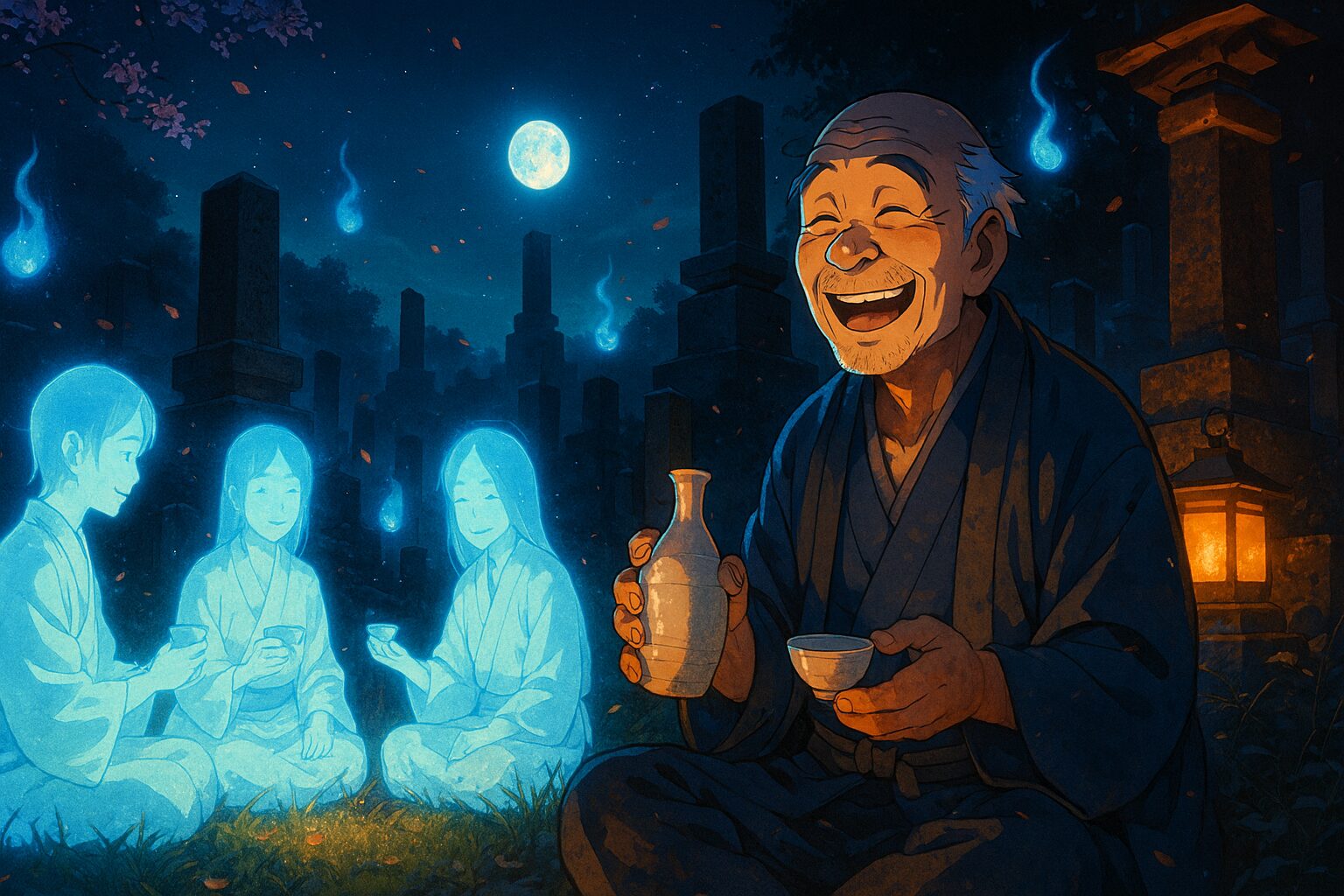Japanese folklore is filled with unique stories that distinguish themselves from Western horror. Among them, “The Ghost’s Sake Banquet” (Yurei no Sakamori) is a masterpiece that symbolizes the Japanese view of life and death, their love for sake, and their tolerance towards “the unknown.”
If you met a ghost in a graveyard at night, what would you do? Would you scream and run away? Or would you offer them a drink? The protagonist of this story chose the latter. Let me guide you into a mysterious and delightful world of spirits.
1. The Story of “The Ghost’s Sake Banquet”
The Sake-Loving Old Man and the Night Road
Once upon a time, in a certain village, lived an old man named Gen-san, who loved sake more than anything else. He was a cheerful man who believed that as long as there was sake, this world was paradise.
One autumn evening, Gen-san enjoyed some sake at a relative’s house in a neighboring village and started heading home in high spirits. The full moon was shining, and the pampas grass was swaying in the wind. On his back, Gen-san carried a large Tokkuri (ceramic sake bottle) he had received as a souvenir.
Lively Voices from the Graveyard
To get back to his village, he had to pass through a lonely forest and walk alongside an old graveyard. Usually, this was a place everyone feared, but the intoxicated Gen-san felt no fear. Humming a tune, he suddenly heard strange sounds coming from the depths of the graveyard.
“Come on, drink and sing!”
“This cup is empty!”
Surprisingly, lively voices and the sound of clapping were coming from between the tombstones. When Gen-san squinted his eyes, he saw several shadows sitting in a circle, bathed in a pale blue light. Their feet were translucent; clearly, they were not of this world. They were Yurei (ghosts).
An Unexpected Guest
An ordinary person would have fainted, but not Gen-san. “Oh? Do ghosts enjoy drinking parties too?” Instead of fear, his curiosity—or rather, his empathy as a fellow drinker—took over.
Gen-san staggered towards the circle of ghosts and called out.
“Everyone, you seem to be having fun. If you don’t mind, would you like to share my sake?”
The ghosts were startled by the sudden appearance of a living human and fell silent for a moment. However, when Gen-san held out the bottle from his back, the ghost who seemed to be the leader grinned.
“Ho, for a living human, you have guts. And you bring fine sake. Alright, join us!”
Farewell at Dawn
From there, a strange banquet began between one human and several ghosts. The ghosts shared their life stories, Gen-san shared village gossip, and they exchanged cups. They were not terrifying monsters, but simply former humans who were lonely and loved good times.
Eventually, as the eastern sky began to brighten, the ghosts started to panic.
“Oops, it’s almost morning. Gen-san, we must thank you for the sake.”
One of the ghosts took out a beautiful gold coin from his kimono and handed it to Gen-san. “Buy more sake with this,” he said, and they vanished like mist.
When Gen-san returned home and checked his hand, wondering if it had been a dream, he found an old but genuine gold coin firmly grasped in his palm. Since then, Gen-san treasured the coin and occasionally went to the graveyard to offer sake.
2. Analysis: Why Do Japanese Ghosts Drink Sake?
Reading this story deeply reveals the unique Japanese view of the soul.
- The Blurred Boundary: In Western ghost stories, the living and the dead are often depicted as opposing forces. In Japan, however, the boundary is very ambiguous. Due to cultural traditions like “Obon,” where spirits return home, ghosts are seen as terrifying yet nostalgic neighbors.
- Communion with Spirits (Naorai): In Shinto, there is a ritual called “Naorai,” where humans consume the food and sake offered to the gods. Sake is a communication tool that connects different worlds. Gen-san sharing cups with ghosts can be interpreted as an unconscious ritual of “Requiem” (comforting the spirits).
3. Cultural Connection: The Spirit of “Omotenashi”
The core of this story is Gen-san’s “Hospitality.” Even if the other party is a ghost, if they seem to be having fun, he shares his sake. This attitude reflects the spirit of “Wa” (Harmony) prevalent in Japanese society.
Instead of excluding, we share. Instead of fighting, we hold a banquet. This solution is distinctly Japanese and contains wisdom for peaceful coexistence. The story also carries the specific Japanese humor that “even gods, buddhas (and ghosts) cannot defeat a drunkard.”
4. What Would You Do?
“The Ghost’s Sake Banquet” is a story about transforming fear into friendship. If you encountered ghosts having a fun party on a night road, what would you do?
Would you run away? Or would you join the circle and say “Kampai!” like Gen-san?
Please let us know in the comments what you think, or how this differs from ghost stories in your country.
Related Links
- Learn more about Japanese Culture (External): Japan National Tourism Organization (JNTO)
- Read more stories (Internal): Japanese Folktale Series Category
はじめに:恐怖と笑いは紙一重?日本の幽霊観
日本の昔話には、西洋のホラーとは一線を画すユニークな物語が数多く存在します。その中でも「幽霊のさかもり(The Ghost’s Sake Banquet)」は、日本人の死生観、酒への愛着、そして「未知のもの」に対する寛容さを象徴する傑作です。
夜の墓場で幽霊に出会ったら、あなたならどうしますか?悲鳴を上げて逃げ出しますか?それとも、持っている酒を差し出しますか?この物語の主人公は、後者を選びました。さあ、不思議で愉快な宴の世界へご案内しましょう。
1. 昔話「幽霊のさかもり」のストーリー
酒好き爺さんと夜の道
むかしむかし、ある村に、酒が何よりも大好きな「源さん(Gen-san)」というお爺さんが住んでいました。源さんは、酒さえあればこの世は極楽だと信じているような、陽気な老人でした。
ある秋の晩のことです。源さんは隣村の親戚の家で振る舞い酒を楽しみ、すっかりいい気分になって家路につきました。空には満月が輝き、ススキが風に揺れています。源さんは背中に、お土産にもらった大きな徳利(とっくり)を一本背負っていました。
墓場からの賑やかな声
村へ帰るには、寂しい森を抜け、古びた墓場の横を通らなければなりません。普段なら誰もが恐れる場所ですが、酔っ払った源さんには怖いものなどありません。「月は出た出た、月は出た~」と鼻歌交じりで歩いていると、ふと墓場の奥から不思議な音が聞こえてきました。
「さあさあ、飲めや歌えや!」
「こっちの盃(さかずき)が空いたぞ!」
なんと、墓石の間から賑やかな話し声や手拍子が聞こえてくるのです。源さんが目を凝らすと、そこには青白い光に包まれた数人の影が車座になって座っていました。足元が透けているその姿は、どう見てもこの世の者ではありません。幽霊たちです。
まさかの飛び入り参加
普通の人間なら腰を抜かすところですが、源さんは違いました。「おや? 幽霊さんたちも酒盛りがお好きかね?」と、恐怖よりも好奇心、いや、酒飲みとしての共感が勝ってしまったのです。
源さんはふらふらと幽霊たちの輪に近づき、声をかけました。
「みなさん、楽しそうですな。もしよければ、わしのこの酒も一緒にいかがかな?」
幽霊たちは突然の生きている人間の登場に驚き、一瞬静まり返りました。しかし、源さんが背中の徳利を差し出すと、リーダー格らしき幽霊がニヤリと笑いました。
「ほう、生きている人間にしては気骨がある。しかも上等な酒を持っておる。よし、仲間に入れ!」
夜明けの別れ
そこからは、人間一人と幽霊数人による奇妙な大宴会が始まりました。幽霊たちは身の上話を語り、源さんは村の噂話をし、互いに盃を交わしました。彼らは恐ろしい存在ではなく、ただ寂しがり屋で、楽しいことが好きなかつての人間たちだったのです。
やがて東の空が白み始めると、幽霊たちは慌て始めました。
「おっと、もう朝だ。源さん、酒をご馳走になった礼をしなきゃならん」
一人の幽霊が、懐から美しい小判を一枚取り出し、源さんに手渡しました。「これでまた酒を買ってくれ」と言い残し、彼らは朝霧とともにスッと消えてしまいました。
源さんが家に帰り、夢だったのかと手の中を見ると、そこには古いが本物の小判が一枚、しっかりと握られていました。それ以来、源さんはその小判を大切にし、時折墓場へ酒を供えに行ったということです。
2. 考察:なぜ日本の幽霊は酒を飲むのか?
この物語を深く読み解くと、日本独自の「霊魂観」が見えてきます。
- 境界線の曖昧さ: 西洋のゴーストストーリーでは、生者と死者は完全に対立する存在として描かれることが多いですが、日本ではその境界が非常に曖昧です。「お盆」のように、死者が家に帰ってくる文化があるため、幽霊は恐怖の対象であると同時に、懐かしい隣人でもあります。
- 神人共食(しんじんきょうしょく): 日本の神道には、神様にお供えした食べ物や酒を人間も一緒に食べる「直会(なおらい)」という儀式があります。酒は、異なる世界をつなぐコミュニケーションツールなのです。源さんが幽霊と酒を酌み交わす行為は、無意識のうちに「鎮魂(霊を慰めること)」の儀式を行っているとも解釈できます。
3. 日本文化との関連:「もてなし」の精神
この物語の核となるのは、源さんの「ホスピタリティ(おもてなし)」です。相手が幽霊であっても、楽しそうにしていれば酒を分かち合う。この姿勢は、現代の日本社会にも通じる「和(Harmony)」の精神です。
排除するのではなく、共有する。戦うのではなく、宴を開く。この解決方法は、非常に日本的であり、平和的な共存の知恵が含まれています。また、この物語は「酔っ払いには神も仏も(そして幽霊も)敵わない」という、日本特有の酒飲みに対する寛容なユーモアも含んでいます。
4. あなたならどうしますか?
「幽霊のさかもり」は、恐怖を友情に変える物語でした。もしあなたが夜道で、楽しそうにパーティーをしている幽霊たちに出会ったらどうしますか?
逃げますか? それとも、源さんのように「乾杯!」と言って輪に加わりますか?
ぜひ、あなたの感想や、あなたの国のゴーストストーリーとの違いをコメントで教えてください。
関連リンク
- 日本文化をもっと知る(外部): 日本政府観光局 (JNTO) – 日本の伝統と文化
- 他の昔話を読む(内部): Japanese Folktale Series Category



コメント